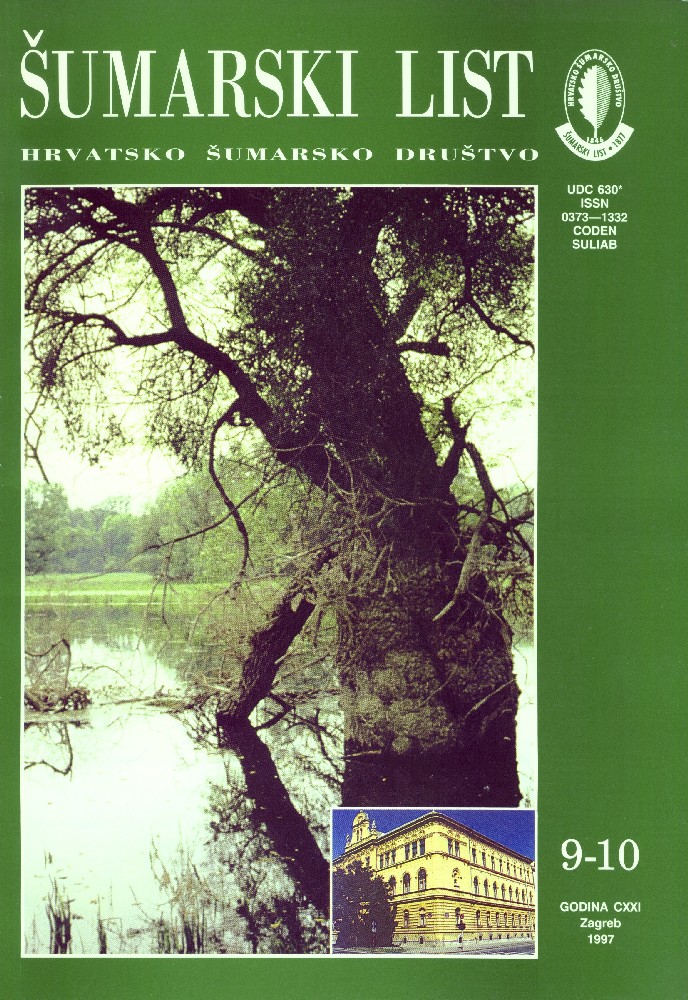
broj: 9-10/1997
pdf (24,8 MB) |
|
||||||||||||||
| IZVORNI ZNANSTVENI ČLANCI | ||
| Matić, S., Anić, I., Oršanić, M. | UDK 630* 233 + 913.001 | |
| Afforestation, Tending and Regeneration as the Basic Prerequisite for Ecological, Social and Economic Development of the Mediterranean pdf HR EN | 463 | |
| Čavlović, J., Marović, T. | UDK 630* 569 (001) | |
| Relations of Fir Tree Increment in the Educational-experimental Forest Facility "Sljeme" pdf HR EN | 473 | |
| Štefančić, A. | UDK 630* 325 + 859 (001) | |
| The Proportion of Wood Assortments in the up-to-7-cm-diameter Stemwood Volume of the Pedunculate Oak, Sessile-flowered Oak and Field Ash - dry type pdf HR EN | 479 | |
| Hitrec, V. | UDK 519.24 + 630* | |
| Application of Stochastics to Scientific Research, Problems - Misconceptins - Risks pdf HR EN | 499 | |
| STRUČNI ČLANCI | ||
| Rubić, G. | UDK 630* 231 + 232 : 232.31 | |
| Acorn Regeneration of the Pedunculate Oak in the Vinkovci Forest Management Area pdf HR EN | 507 | |
| Summary: A delicate task, forest regeneration requires fair knowledge of the biological and technical-technological issues, and a high level of operating organization. A great number of operations must be done at the precisely timed periods of time. Any delay in the technological procedure ends with bad results, even though other work may have been well performed. Within the vast range of many jobs, some are costly, so that the problem acquires very significant economic dimensions. The acorn regeneration technology of the Pedunculate oak in the Vinkovci forest management has altered the phase of the stand preparation for fecundation and acorn sewing. Various preparation methods do not influence the success of regeneration with the up-to one-year old young plants. Therefore we suggest method C with acorn sewing using a dispersing device. The method is equally efficient as the ones applied so far, although it considerably reduces the costs, and is environmentally welcome. The suggested method may regenerate large areas within optimal time periods, which is of great importance to us. Due to possible lacks of acorn, and because genetically better seeds provide easier and safer regeneration, a pedunculate oak seed plantation should be established. The preparations should include radical clearing of all wood undergrowth (ifpossible, the herbaceous plants, too). Young growth will thus get optimal developing conditions. It is recommendable, that the acorn is sewn readily upon collecting. At hauling following the final cut, soil should be damaged as little as possible. Following the seed cut, final cut should take place as soon as possible. Stand regeneration with the pedunculate oak acorn is done in the Vinkovci forest management with great expectations. The only factor that can impact the regeneration are the over-multiplied field-mice, which may destroy the young growth on the regenerated areas. | ||
| Tomašević, A. | UDK 630* 919 + 630* 11 +233 | |
| History of Afforestation on the Island of Vis pdf HR EN | 515 | |
| Gračan, J. | UDK 630* 231 | |
| The Hemeroby of Austrian Forest Ecosystems pdf HR EN | 527 | |
| Frković, A. | UDK 630* 159 | |
| Sixty Years of the Temporary CIC Formula for Evaluation of Deer Antlers pdf HR EN | 533 | |


